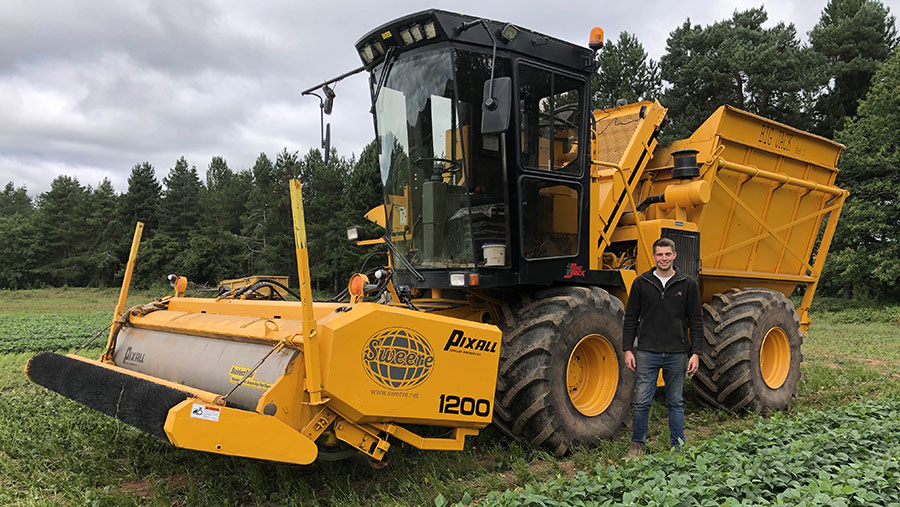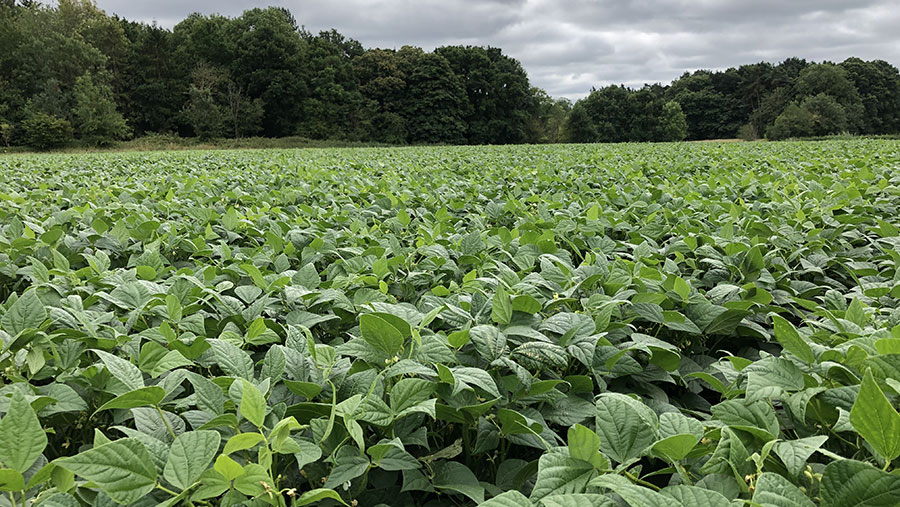#FeedTheNation: Dwarf bean harvest off to flying start
 Alex-Baylis with the farm's self-propelled bean harvester
Alex-Baylis with the farm's self-propelled bean harvester The dwarf bean harvest is off to a good start in Worcestershire, where 150ha of the crop is grown and packed on farm, before being sold to supermarket retailers.
Harvest started on 10 July at MWW Farms in Worcester, where the firm’s trainee crop manager, Alex Baylis, told Farmers Weekly initial bean yields are looking well, despite the challenging dry conditions in spring.
“For early harvest yields, starting July, we’re looking at about 10 beans a plant, and will increase to 15-20 a plant later in the season, due to increased temperatures,” said Mr Baylis.
See also: Harvest 2020: Poor to chuffed – farmers rate yields so far
This season, the bean harvest started slightly later than usual as a result of the dry spring.
Crops found it difficult to emerge in the drought-like conditions, which meant additional irrigation was required on top of the standard applications at six weeks of growth – and then again when the beans began to develop.
“The ground was just too dry for the crops to germinate – they couldn’t get up and away like usual, so we had to irrigate them to get them to establish,” added Mr Baylis.
Supermarket supply
Mr Baylis said creating a continuous supply of beans for retailers throughout the season is key, which is why drilling and harvesting of the crop is staggered into blocks.
The first beans to be harvested were planted on 20 April, whereas the last blocks of beans only went into the ground on 15 July. These will be cut during late September and early October.
“We aim to finish bean drilling at the same time harvest starts, which allows us to supply the supermarkets for as long as possible,” said Mr Baylis.
Using a precision drill means crops are now more uniform due to reduced competition and increased airflow, which is essential to minimise disease pressure and deliver good-quality produce.
Mr Baylis also pointed out that the company had invested in a self-propelled bean harvester four years ago to enhance harvesting efficiency and drastically cut labour costs, replacing about 80 employees who previously hand-picked the crop.
“The bean harvester removes the beans from the plant and delivers them into the hopper, leaving the plant in the ground,” he said.
“This allows us to cover a greater area in less time, ensuring the product is delivered to the packhouse in good time to avoid the heat of the day and therefore give the end consumer fresher, quality food.”

© Emma Gillbard/MA Agriculture
Rotation
Mr Baylis explained that the farm works closely with neighbouring arable farmers to integrate vegetable production into their rotations.
After the beans are harvested, a brassica crop is planted for harvesting in October. This means two crops can be grown in just one season.
“Vegetable production offers arable growers an effective break crop, which is particularly important now many are looking for oilseed rape alternatives,” he said.
Due to the loss of the seed treatment chlorpyrifos, which is used to control pests such as the bean seed fly, rotation has never been more important.
“The forthcoming bean crop will be drilled into clean stubble where no legumes have been grown for the previous four years, to minimise pest attacks, so we will be looking to work even closer with arable farmers,” said Mr Baylis.
#FeedtheNation
Farmers Weekly is getting behind the #FeedtheNation campaign to back UK farmers working flat out to produce safe, affordable and reliable food to feed the nation this harvest.
With our partners, we are raising public awareness of this campaign by highlighting the actions farmers are taking to get food to consumers.
Join in the campaign by sharing your stories with us on Facebook, Twitter or Instagram using the hashtag #FeedtheNation or email us at philip.case@markallengroup.com or telephone 020 8652 4905.



